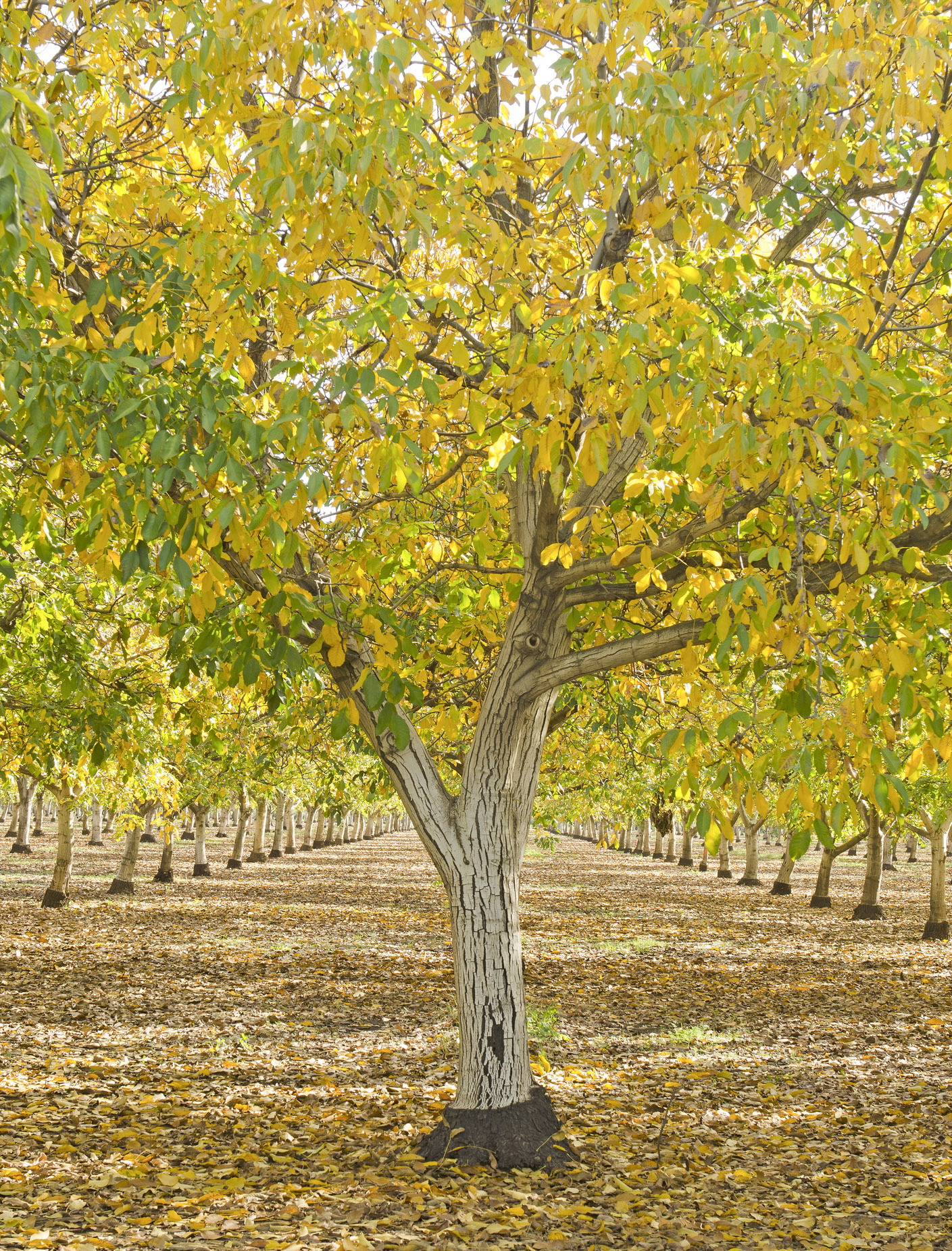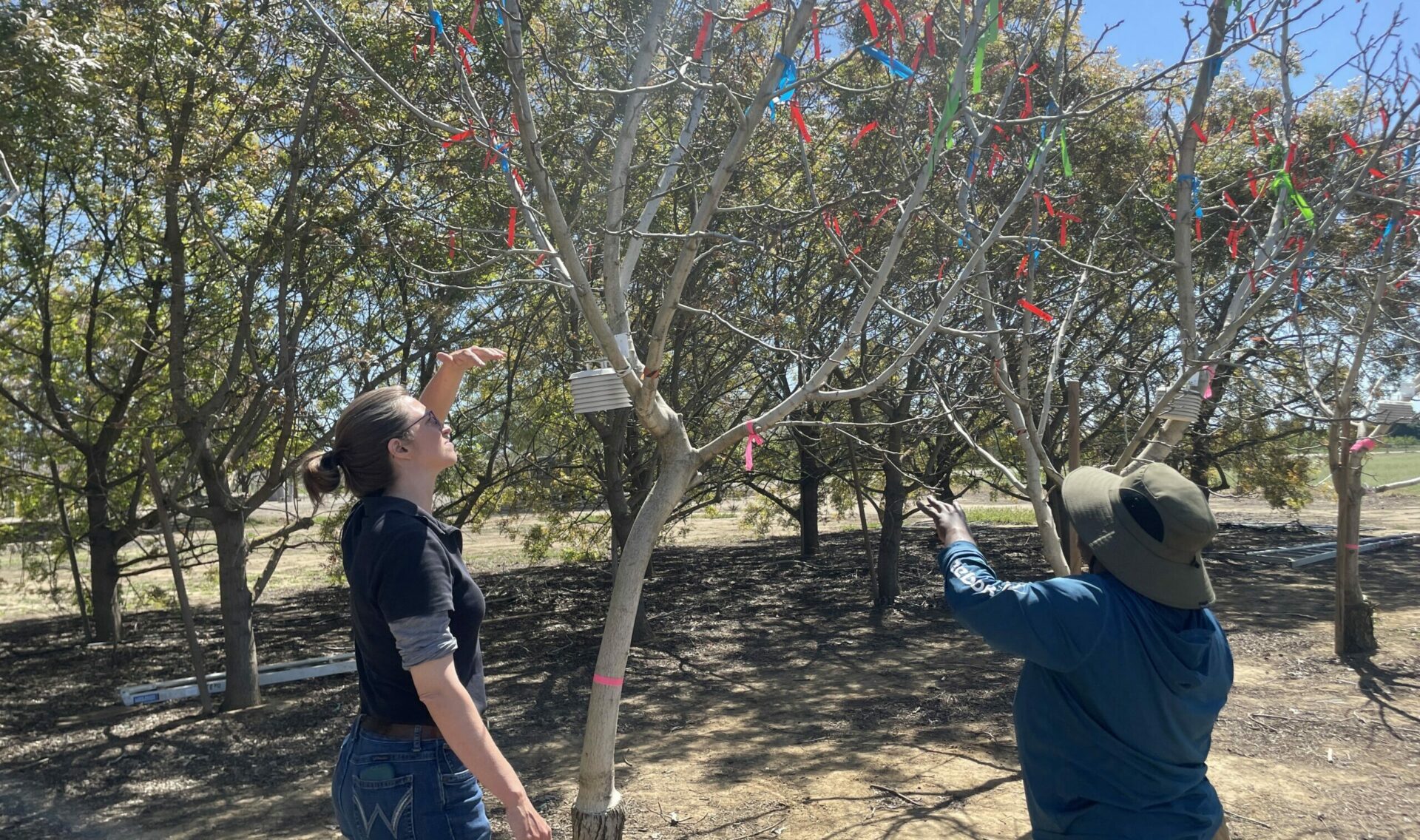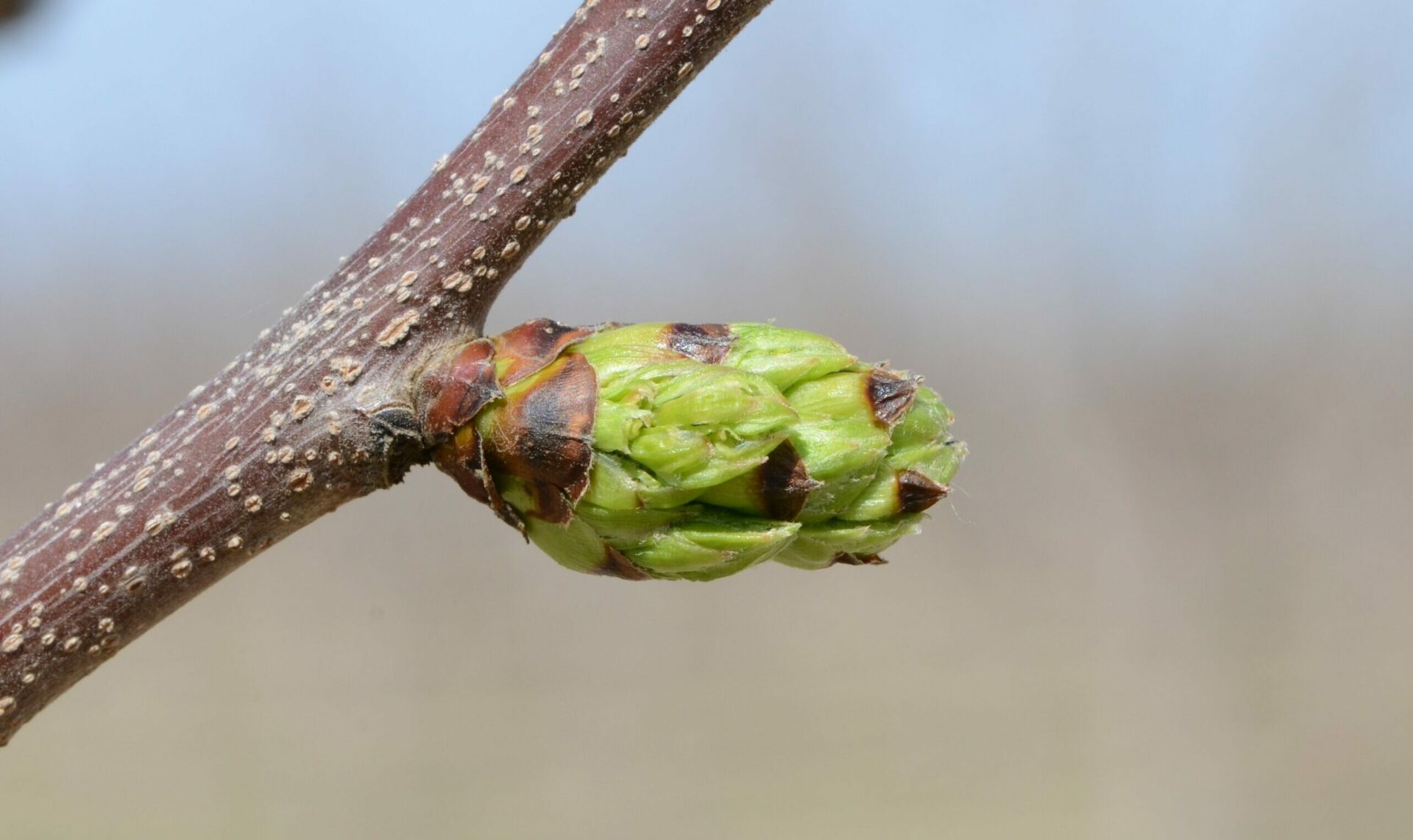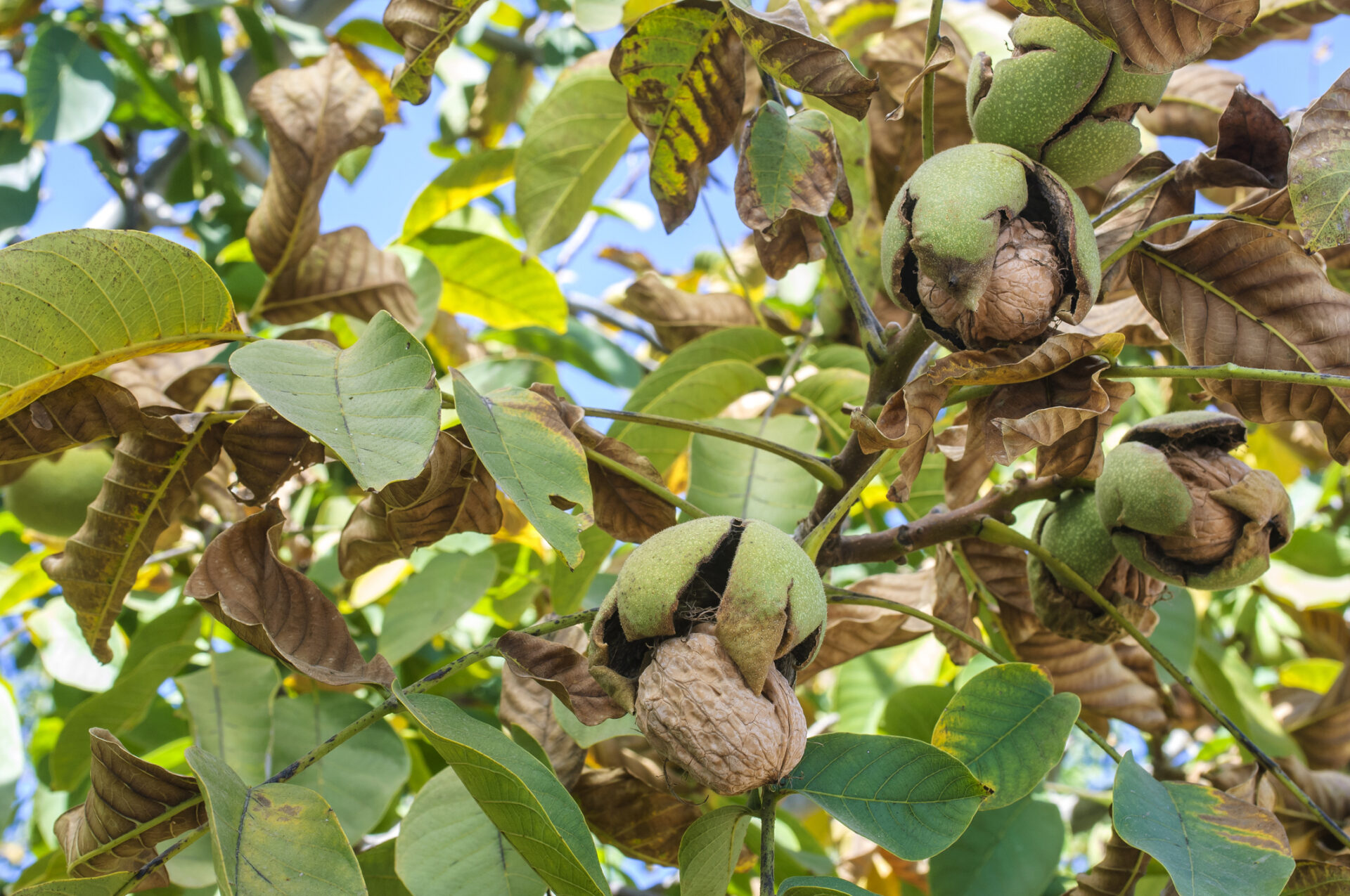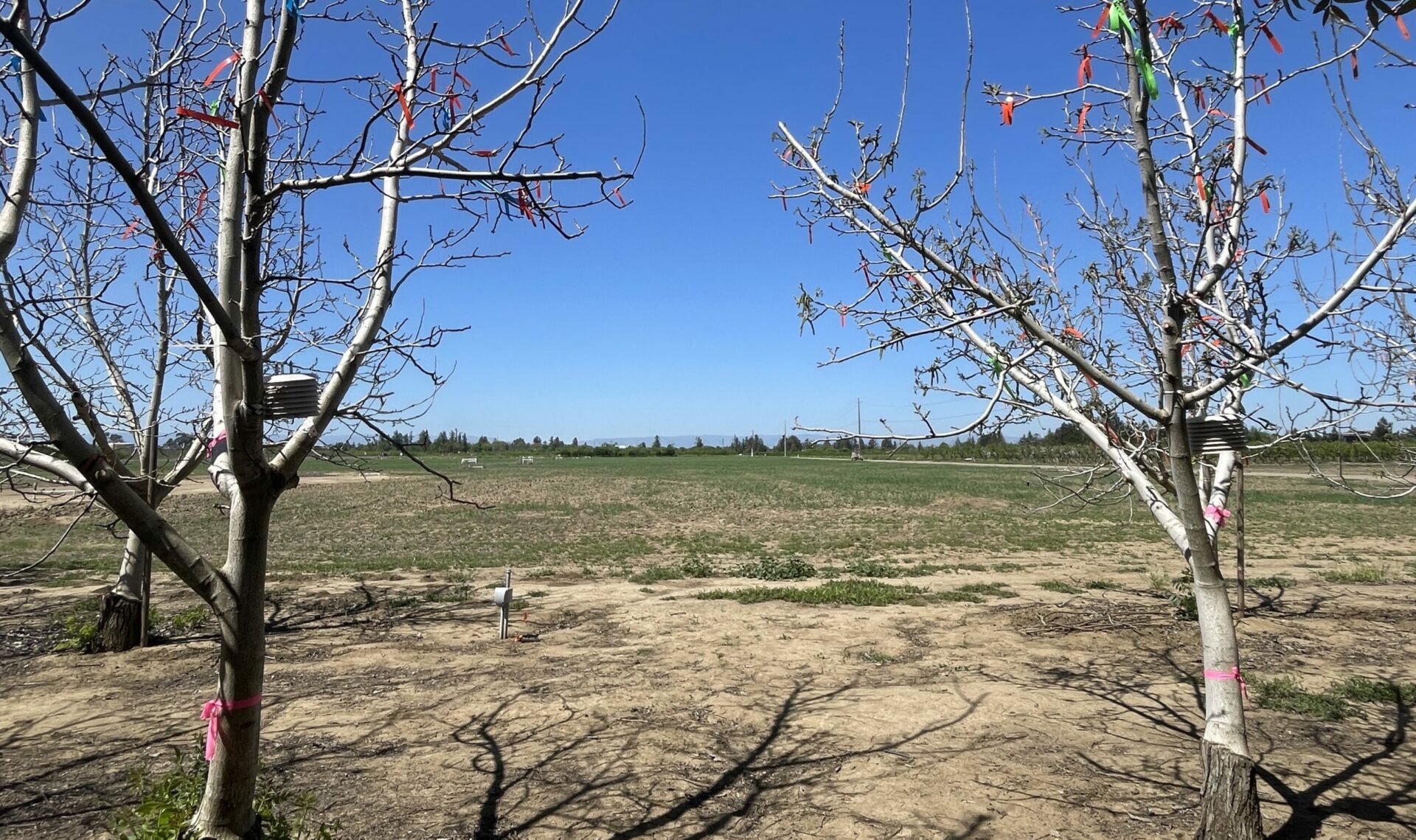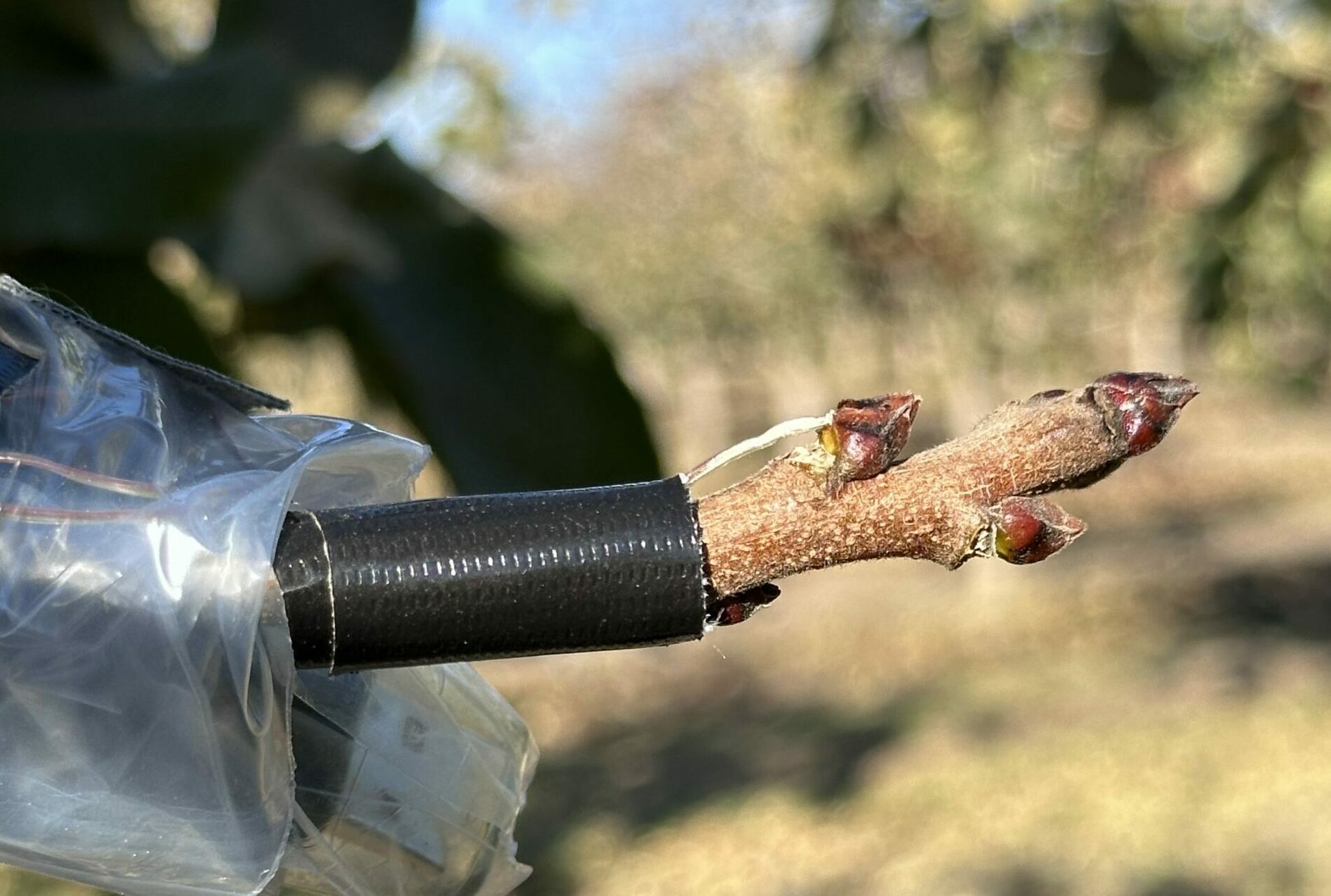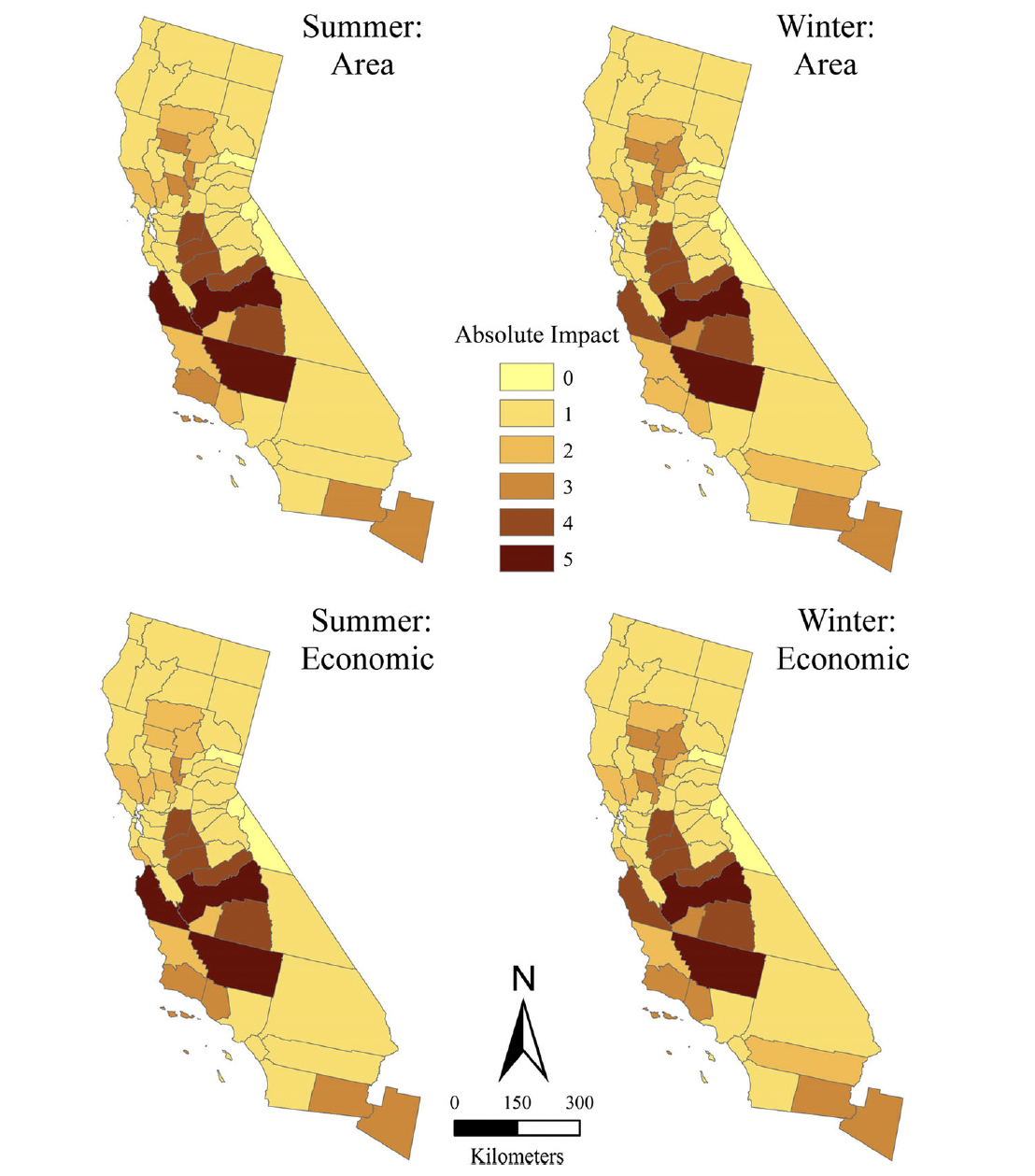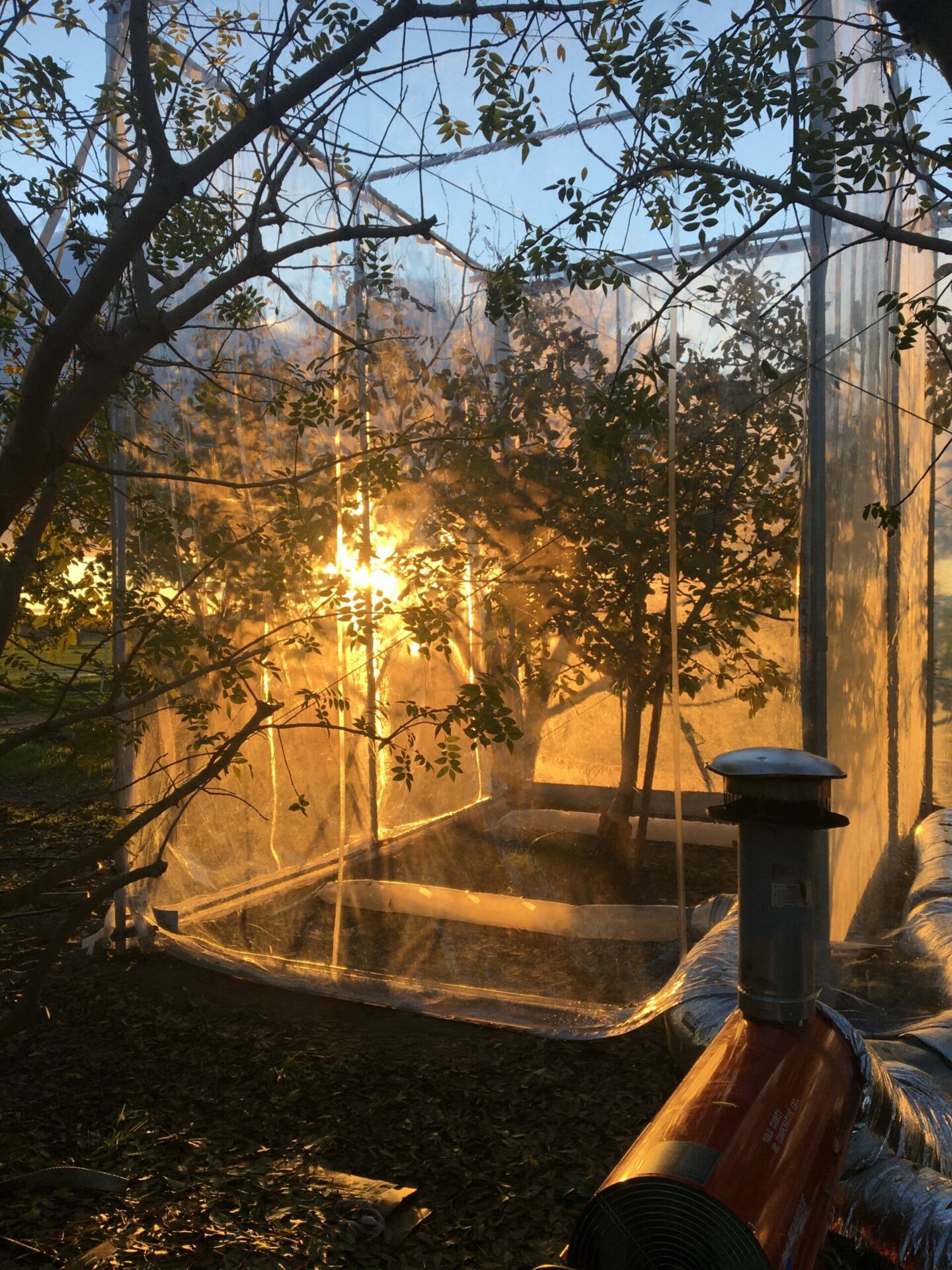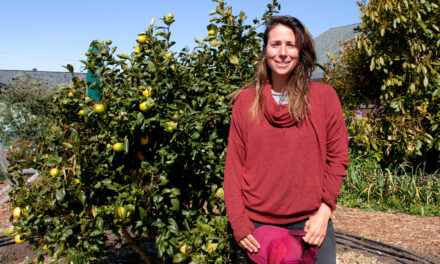Photo: tfoxfoto, I-Stock
Orchards Not So Chill with Warmer Winters
In a research plot near the University of California, Davis, tree crop researcher Kat Jarvis-Shean and lab assistant Mat Talton are checking on their warmed-up walnut trees. For the past four winters, Jarvis-Shean has been surrounding four trees with clear-sided, open-topped plastic tents during their dormancy period and pumping in hot air to heat them to 5°F above ambient temperatures. Walnuts are among the most sensitive of tree crops to winter temperatures and need a minimum amount of cool time to produce high quality nuts. Since climate change is chipping away at chill time in the valley, researchers are experimenting with what might happen under the worst case and best case temperature scenarios. “The idea is to force conditions to see what the tipping point will be in the future,” says Jarvis-Shean.
Extremes-in-3D
A five-part series of stories in which KneeDeep Times explores the science behind climate extremes in California, and how people and places react and adapt.
Supported by the CO2 Foundation and Pulitzer Center.
FULL READ
Orchards Not So Chill with Warmer Winters
In a research plot near the University of California, Davis, tree crop researcher Kat Jarvis-Shean and lab assistant Mat Talton are checking on their warmed-up walnut trees.
For the past four winters, Jarvis-Shean has been surrounding four trees with clear-sided, open-topped plastic tents during their dormancy period and pumping in hot air to heat them to 5°F above ambient temperatures. For research purposes, she says the 5°F increase mimics the worst-case scenario for temperature conditions in California’s Central Valley by 2050 and the best-case scenario by 2100.
“We’re making our own low-chill winter,” says Jarvis-Shean, UC Cooperative Extension orchard systems advisor for Sacramento, Solano, and Yolo counties. “The idea is to force conditions to see what the tipping point will be in the future.”
EXTREMES-IN-3D
A five-part series of stories in which KneeDeep Times explores the science behind climate extremes in California, and how people and places react and adapt.
Series Home
Click here to enter
Supported by the CO2 Foundation and Pulitzer Center.
Walnuts are among the most sensitive of tree crops to winter temperatures. After walnuts are harvested and trees lose their leaves and go dormant in the fall, they need a minimum amount of time in cool conditions to gather nutrients, then wake up from their slumber and flower at the right time for pollination. If they don’t get enough time under 45°F in the winter, fewer buds will open in the spring, meaning fewer flowers opening, and, subsequently, lower yields of high-quality, harvestable fruit.
Here in Yolo County, UC agricultural economists estimated that the number of hours under 45°F has dropped two hours on average every winter since 1910. Jarvis-Shean predicts that in the next 20 to 40 years, Central Valley walnut orchards will get up to 20% less winter than in the 1950s.
“We know that this is coming,” Jarvis-Shean says. “I’m a solutions-oriented person. How can we adapt to this?”
Chill Time on the Decline
Amber Kerr, scientific consultant for Carbon Direct (a carbon-management company) and lecturer at UC Berkeley and Las Positas College, analyzed the vulnerability to climate change of California’s top 14 specialty crops, which account for 88% of the state’s specialty crop value. For many of these crops, including wine grapes, strawberries, leaf lettuce, garlic, and broccoli, California grows at least 90% or more of all that is produced in the United States, valued at more than $22 billion in 2021. In a 2018 article in the journal Climatic Change, Kerr and colleagues predicted that high-value crops that have the most to lose from reductions in winter chill will include walnut, pistachio, cherries, and most stone fruits, such as peaches and nectarines.
The amount of chilling required varies tremendously from crop to crop and among cultivars of the same crop, ranging from 200 hours for low-chill almonds to upwards of 1,200 for walnuts. (The UC Fruit and Nut Research and Information Center posts several online chill calculators to help growers keep track of how much chill their crops are getting.)
As a postdoctoral scholar in the UC Davis departments of Plant Sciences, and Land, Air, and Water Resources, Eike Luedeling published an important study on climate impacts on California tree and nut crops in PLOS One in 2009. The study compared California weather scenarios for 1950 and 1990 and modeled projected temperatures for 2041-2060 and 2080-2099 under various greenhouse gas scenarios developed by the Intergovernmental Panel on Climate Change (IPCC), to understand how much chill growers can safely expect under each scenario.
Distribution of orchards requiring winter chill, major producing counties, and subdivisions of the Central Valley. Source: Leudeling, et al., PLoS One 2009.
In 1950, California growers could rely on 700 to 1200 chilling hours depending on location, Luedeling found. By 2000, these numbers had already declined by 30% in some California growing regions.
But winter chill hours is a crude measurement that simply adds up how many hours temperatures are below 45°F, beginning on November 1 through the spring. Studies by several research groups have shown that the metric of “chill portions” is a more accurate measure of chill accumulation, especially when talking about climate change. “Chill portions” captures how trees “perceive” temperature internally, and they are less likely than “chill hours” to lead to exaggerated expectations of climate change impacts, Luedeling says. “Adopting this metric would considerably help the tree crop industry in their adaptation efforts.”
Regardless of the metric used, Luedeling found that the Central Valley can expect sharp declines in the chill accumulation that orchard crops receive. “Winter chill declined substantially for all emissions scenarios, with the area of safe winter chill for many tree species or cultivars declining 50% to 75% by mid-21st century, and 90% to 100% by late century,” Luedeling and coauthors wrote. “We expect few tree crops to be unaffected by these changes.”
For example, for cultivars that require more than 700 hours of chilling — such as many varieties of walnuts, apricots, and plums — only between 23% and 46% of the Central Valley would remain suitable for producing these crops by 2041-2060 and between 2% and 10% by 2080-2099.
Fifteen years later, Luedeling — now a professor of horticultural sciences at University of Bonn, Germany — says he is fairly certain that his findings would not be much different if he repeated the analysis today, with the updated climate scenarios that are available now. “If anything, the climate is changing a bit faster than we all thought.” While he was initially hesitant to use the IPCC’s most extreme A2 scenario in the paper, “It turns out that warming is happening roughly as fast as that scenario predicted.”
Indeed, insufficient accumulation of winter chill is becoming more common in California. Growers generally expect to get sufficient chill in nine out of ten years, but there were two warmer winters in a row in 2013-14 and 2014-2015.
Female flower of “Golden Hills’ variety of pistachio, just before opening. When trees don’t get enough winter chill, males and females may bloom asynchronously, leading to lower yield. Photo: Gurreet Brar
Pistachios are grown with alternating rows of male and female cultivars. The female cultivar ‘Kerman’ requires about 58 chill portions and the male cultivar ‘Peters’ requires 60 to 65 chill portions. Chill portions during those two winters were in the mid-50s. “In many orchards we could never get to chill accumulation for ‘Peters’,” says Gurreet Brar, professor of pistachio physiology and pomology at California State University, Fresno. “It’s important to have synchronized bloom to provide pollination.”
When a good two-year average yield would be 4,000 pounds of pistachios per acre, Brar says, in some orchards 2015 yields averaged 600 pounds per acre and many kernels did not split open.
Likewise, cherry yields were down 60% during those two back-to-back low-chill winters, Jarvis-Shean says. “You could see it in the field very dramatically,” Jarvis-Shean says. “That gets your attention.”
Interventions
Agricultural researchers are searching for ways to keep affected trees cooler during the critical winter months. “We don’t leave those valuable crops to their own devices,” Kerr says. “We tend to control every aspect of their needs.”
Sprays of horticultural oils may inhibit transpiration and help trees like pistachios to bloom synchronously, while kaolin, a naturally occurring clay also used in skin masks, can reflect sunlight away from trees, helping to keep them cooler. Sprays of synthetic chemicals may help trees that don’t get enough winter chill to break out of dormancy at the right time.
In the experimental walnut orchard, Jarvis-Shean is comparing several different chemical and fertilizer treatments to understand whether the eight-year-old ‘Chandler’ variety walnut trees grown in the artificially warmer conditions can make buds and flowers at the right time in spring. “We monitor the buds through May to see how many open, and when.”
She’s testing four dormancy-breaking treatments on different branches of each tree in the study, including the growth regulator hydrogen cyanamide (Dormex), concentrations of calcium ammonium nitrate, and a nitrogen fertilizer “cocktail.”
Yolo County experienced enough chilling time for walnuts this past winter. Out in the field on April 11, Jarvis-Shean’s control walnut trees that were not heated had just that week started sprouting catkins, while the trees that were heated to simulate a low-chill winter had not yet experienced “budbreak.”
“It’s nice to have the trees do what science tells me they should,” Jarvis-Shean says.
Talton has been getting up on a ladder to catalog buds and catkins on tree branches that have received different treatments, which are marked with brightly colored plastic ribbons. It’s a bit too early to say whether the treatments will help the warmer walnut trees produce nuts at the same level as those that received sufficient winter chill.
Brar has investigated non-chemical treatments such as netting and kaolin clay to reduce the temperatures of pistachio buds and improve their capacity to bloom. A recent study during a winter with sufficient chill accumulation found that these strategies “… do not have significant effect on improving nut growth and development, yield, or quality in pistachios,” he reported to the California Pistachio Research Board.
Now Brar is looking at whether stressing trees for water, coupled with a plant growth regulator spray (ABA) or zinc sulfate, might enhance chill accumulation and help bring trees into endodormancy sooner. He’s also investigating the use of cover crops to keep orchard temperatures lower. “Even one or two degrees in hourly temperatures might be a lifesaver in marginal years,” he says.
Cal State Fresno researchers studying the impact of climate change on pistachio crops use bud sensors to measure the temperature inside flower buds. Photo: Gurreet Brar
Jarvis-Shean’s previous research found that hydrogen cyanamide increased the amount of budbreak but not its timing, which is key: dormancy-breaking chemicals can be applied only when 70% of an orchard’s chill requirements have been met, according to the UC Fruit and Nut Research Center. “It’s a tough knot to untie because you have to spray 30 days before budbreak, but it’s hard to know exactly when that will be,” Jarvis-Shean says.
The chemical is registered for use on some California crops, but its use is severely restricted because of toxicity concerns. “The application requirements are so complicated that the pistachio industry is looking for other alternatives,” Brar says. “We’re glad that we have it but we don’t want to rely on that for a long time.”
Wins, Losses, and Draws
Winter chill accumulation is just one factor that will affect the ability of California growers to produce economically viable crops from year to year in a warming world. Unpredictable rainfall, decreases in winter snowpack, and more-frequent extreme-weather events and wildfires will all play a part.
Another option would be to grow some crops in different locations with cooler microclimates, Luedeling notes, such as along major rivers, in the foothills of the Sierra Nevada and Coast Ranges, close to the Sacramento Delta, and in parts of the Central Valley that have frequent cooling fogs — although fog will likely be less frequent in many of those places.
A 2018 analysis by Amber Kerr et al. in Climatic Change explored the sensitivity of 14 Central Valley specialty crops to climate change by midcentury, on a scale of 0 to 5, with 0 being the lowest impact and 5 being the highest. Source: Kerr
In her analysis, Kerr noted that there will be wins, losses, and draws in agriculture due to climate change. Crops that are likely to be unaffected by climate change include low-chill cultivars of almonds (200 to 400 chill hours) and grapes, although wine grapes would likely suffer in quality. Citrus could benefit from the reduced risk of frost; warmer temperatures could increase avocado and broccoli yields; and melons would likely expand in acreage. “There is no single locus of vulnerability in California,” Kerr and colleagues wrote. “Different crops respond in different ways, and chill-sensitive perennial crops in the Central Valley are of particular concern.”
Kerr notes that more carbon dioxide in the atmosphere will have a “fertilizer effect” on plants. “Extra carbon dioxide helps crops grow faster with a little less water, but it also tends to make crops a little less nutritious on average.” The effects of carbon dioxide also vary from crop to crop. “Some will have a higher growth rate. It’s a very complex phenomenon.”
Breeding for the New Normal
Regardless of how effective various dormancy-related treatments are, few agricultural researchers believe that they are a long-term solution to lower levels of winter chill. “They’re an interim solution until breeders can come up with better cultivars that can grow with less winter chill and produce crops that consumers want to eat and buy,” Jarvis-Shean says.
But breeding new varieties that require less chill, replacing old orchards with new ones, and waiting for the trees to mature enough to bear fruit can take 30 years on average. “The challenge with breeding is that it takes a long time,” says Lauren Parker, research program manager for the USDA California Climate Hub.
The most urgent need is “making sure that growers are aware of what’s coming,” Parker continues. “Producers need to prepare. If they are putting in a whole new orchard that they need to produce for the next 20 to 30 years, they need to know what the climate in that area will be for 30 years.”
A UC Davis research plot where walnut trees are warmed during winter dormancy to simulate future climate conditions. Photo: Katherine Jarvis-Shean
Research into lower-chill cultivars is generally being conducted at academic institutions within the University of California and California State University systems, with funding from industry organizations for specific crops. “With the right investment of resources, we can ‘science our way’ through the chilling requirement problem,” Jarvis-Shean says. “There are good reasons to think that we’ll come up with new varieties that will work.”
The agricultural industries that will be most affected by the warmer winters that will accompany climate change do not appear to have their heads in the sand. “I am an optimistic person. I’m not looking at a doomsday scenario in terms of pistachio growing,” Brar says. “I think we are keeping pace, and we will see more cultivars requiring low-chill in 25 to 50 years.” A shift in the geographical areas where pistachios are planted may be necessary, he adds
“In 25 years, we will absolutely be growing walnuts,” Jarvis-Shean adds. “We’ll also be growing them in 75 years, but not in every area that currently has a walnut footprint — but certainly in the Central Valley.”
EXTREMES-IN-3D
SERIES CREDITS
Managing Editor: Ariel Rubissow Okamoto
Web Story Design: Afsoon Razavi, Vanessa Lee & Tony Hale
Science advisors: Alexander Gershunov, Patrick Barnard, Richelle Tanner
Series supported by the CO2 Foundation.
Early Reporting supported by Pulitzer Center, Connected Coastlines.
Banner video: Ochards along the Sacramento River by Jak Wonderly






